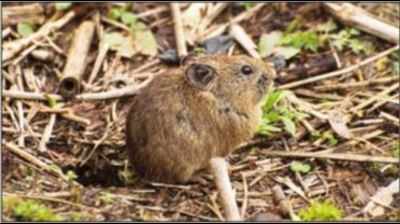- News
- City News
- bengaluru News
- Bengaluru researchers discover rat-like mammal species in Sikkim Himalayas
Trending
This story is from September 27, 2016
Bengaluru researchers discover rat-like mammal species in Sikkim Himalayas
hen PhD student Nishma Dahal embarked on her first trip to east Sikkim, little did she know it would lead to a stunning discovery in the eastern Himalayas.

hen PhD student Nishma Dahal embarked on her first trip to east Sikkim, little did she know it would lead to a stunning discovery in the eastern Himalayas.
BENGALURU: When PhD student Nishma Dahal embarked on her first trip to east Sikkim, little did she know it would lead to a stunning discovery in the eastern Himalayas. The efforts of Nishma and other researchers from National Centre for Biological Sciences (NCBS) have led to the identification of a new species of pika, a mammal which resembles a tailless rat.
The new species, Ochotona sikimaria, is an important part of the ecosystem and is vulnerable to climate change.Members of the rabbit family, pikas have been in the news in North America for their sensitivity to increasing temperature, which has caused several populations to go extinct. Pikas live on high altitudes in mountianeous regions, which makes them more susceptible to habitat loss due to the increasing global temperature.
The discovery was a great challenge for Nishma as most pika species closely resemble one another. She started her work by collecting pika pellets to extract the DNA and identify the species.
Though the pellets are puny, Nishma was successful in amplifying the mammal's DNA from them. When Nishma compared these DNA sequences to those of other pika species in the world, she found them to be quite different. But this was only the beginning of her mission.
The NCBS research reveals while Ochotona sikimaria appears similar to the Moupin pika (found in China), they are quite distinct from a genetic and ecological perspective. So far, the new species seems to be limited to Sikkim. The NCBS team searched for the Sikkim pika in other Himalayan regions, including
All is not well for this tiny mammal, says Nishma. "Unlike other mammalian species inhabiting such harsh environments, Pikas do not hibernate. They prepare for winter by collecting and storing hay piles. We must investigate their vulnerability to increasing global temperatures, and to do so we must better understand their ecology and population dynamics. Such information is lacking in the case of Asian Pikas," she said.
"The oppo rtunity to work on Himalayan biodiversity has been amazing, and I have learned how little we know about our own species. Pikas are ecosystem engineers, and we must understand more about them to protect them," said Uma. The study has been published in the journal Molecular Phylogenetics and Evolution.
The new species, Ochotona sikimaria, is an important part of the ecosystem and is vulnerable to climate change.Members of the rabbit family, pikas have been in the news in North America for their sensitivity to increasing temperature, which has caused several populations to go extinct. Pikas live on high altitudes in mountianeous regions, which makes them more susceptible to habitat loss due to the increasing global temperature.
The discovery was a great challenge for Nishma as most pika species closely resemble one another. She started her work by collecting pika pellets to extract the DNA and identify the species.
Though the pellets are puny, Nishma was successful in amplifying the mammal's DNA from them. When Nishma compared these DNA sequences to those of other pika species in the world, she found them to be quite different. But this was only the beginning of her mission.
To prove it was indeed a new species, Nishma had to compare the Sikkim pika to its close relatives, which are found in China. It took Nishma and Uma Ramakrishnan, whose laboratory at NCBS led the study, two years to build collaborations with researchers from the Chinese Academy of Sciences, Zoological Museum of Moscow and Stanford University to get detailed data on the sister species.
The NCBS research reveals while Ochotona sikimaria appears similar to the Moupin pika (found in China), they are quite distinct from a genetic and ecological perspective. So far, the new species seems to be limited to Sikkim. The NCBS team searched for the Sikkim pika in other Himalayan regions, including
Arunachal Pradesh, central Nepal (Annapurna and Langtang), Ladakh and Spiti but to no avail.
All is not well for this tiny mammal, says Nishma. "Unlike other mammalian species inhabiting such harsh environments, Pikas do not hibernate. They prepare for winter by collecting and storing hay piles. We must investigate their vulnerability to increasing global temperatures, and to do so we must better understand their ecology and population dynamics. Such information is lacking in the case of Asian Pikas," she said.
"The oppo rtunity to work on Himalayan biodiversity has been amazing, and I have learned how little we know about our own species. Pikas are ecosystem engineers, and we must understand more about them to protect them," said Uma. The study has been published in the journal Molecular Phylogenetics and Evolution.
End of Article
FOLLOW US ON SOCIAL MEDIA










